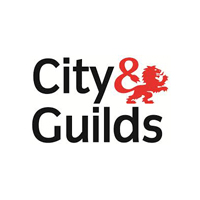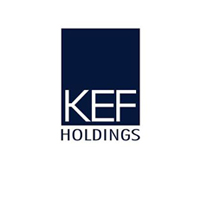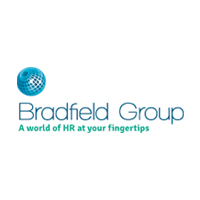PeopleFirst HR Consultancy attended the Achieving Women Forum 2017, organised and hosted by Entrepreneur Magazine.
Earlier this month PeopleFirst HR Consultancy attended the third edition of the Achieving Women Forum hosted by Entrepreneur Magazine, addressing the methodology of business.
The topics of discussions included:
- ‘Keys to the Kingdom: Getting into the C-Suite,’
- ‘The Hard Sell: Building Your (And Your Business’) Brand Value’
- ‘Scaling through Sales: Funding Your Enterprise’s Growth With Your Customers’
The panellists presented their own insightful experiences on attaining the keys to the C-suite, cultivating and improving brand identity, targeting the right audience and employing the correct marketing strategies. The forum showcased some very successful and inspiring women within the UAE. Among these were:
- Lubna Qassim: Executive Vice President and Group General Counsel
- Donna Benton: Launched and Founded ‘The Entertainer’
- Alanoud Faisal: Co-founder of Invert.com, a London-based digital platform, Advisory Chairwoman of ella, a Dubai-based media platform for women in the Middle East, Founding Member of Makeen, a not-for-profit Saudi business incubator for women and a Global Ambassador for 10KSA, a world record breaking holistic health awareness and education initiative in Saudi Arabia.
These women and the other panellists portrayed their proven perseverance to achieve leadership roles in the MENA business sector.
Ultimately, the forum called upon all working women to discover, network and connect with one another to help and support each other to elevate them on a personal and professional level.
Learning and Development: A Strategic Function:
Stage 3: Implementation and Delivery
Over the past two months, we have reviewed the first two stages of the training cycle with the aim of creating a better understanding of the key aspects of an integrated and holistic approach to L&D. Following on from April’s edition of the newsletter which focused on stage 2 of the training cycle – Design and Development, we will now spend some time to discuss stage 3 ‘Implementation & Delivery’. As a reminder, the four stages of the training cycle are illustrated below:
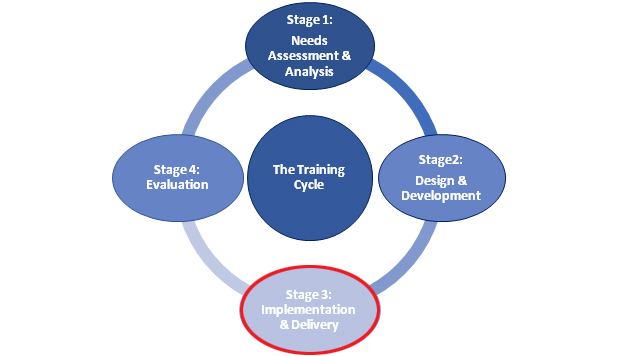
One of the key challenges for many L&D professionals during the implementation and delivery stage is how to engage participants in a way that is meaningful and productive. Regardless of the medium used for this, albeit digital or face to face, the training environment must be such that participants feel safe, comfortable and free to express themselves openly which are all key ingredients to aid the learning process.
Planning for implementation and delivery should ideally begin during the Design stage. This starts with understanding the needs and background of the target audience which includes their previous experiences, their skills, their knowledge and their specific goals and expectations from the learning intervention which can directly impact their motivation and participation.
In an ever evolving world of L&D, more and more professionals are connecting through social interfaces to share expertise and these interfaces are now considered obvious and progressive channels for engaging learners. Learning through mediums such as e-learning, social learning platforms, on the job training, and peer learning are all becoming more and more popular compared to the traditional trainer led, classroom based approach. Some of the benefits of these evolving mediums include cost effectiveness, efficient use of time and resources, independent and self-directed learning and enhanced knowledge sharing. One of the potential pitfalls however, to watch out for when using social and digital learning platforms is to ensure the authenticity of the content and source.
Where trainer led, classroom based, training is necessary, an appropriate mix of interactive activities and methods that offer differentiated learning and complement theoretical concepts should be considered. This may include, but not be limited to, hands-on individual activities, group exercises, presentations, simulations, case study analysis etc. The table below (adapted from Calao, 2011) presents a comparative analysis of the most commonly used training methods:

For classroom based training, when it comes to trainer selection, it is important to consider where this expertise might come from. In addition to the obvious external sources, organisations should consider internal resources which can prove to be a more cost effective alternative and bring with them specific subject matter expertise and an understanding of the business context. This can also be a very good development opportunity for your employees.
The implementation and delivery aspect of the overall training cycle is the most impactful in many ways and contributes significantly to the overall participant experience and the learning process.
Learning and Development: A Strategic Function, Stage 4: Evaluation
Over the past few months, we have been looking at the stages of the training cycle with the aim of creating a better understanding of L&D as a strategic function. In this newsletter, we talk about the final stage of the cycle i.e. Evaluation, which is undoubtedly an area of interest for all businesses. As a reminder, the four stages of the training cycle are illustrated below:

Although Evaluation is the final stage of the training cycle, it is very closely linked to stage 1 which is the Needs Assessment and Analysis stage. This link is important as all L&D activities should begin with a clear understanding of the business priorities and the expected outcomes, and end with a robust mechanism to measure the impact of the investment. It is important to measure the effectiveness of any L&D intervention at both an organisational and individual level as this can actually help to steer the investment in terms of time, money and effort so that it complements and supports the actual needs of the business. This calls for the L&D function to evolve into a more consultative role and consider business priorities as the basis of employees’ development.
The outcome of the Needs Assessment (stage 1 as discussed in our March newsletter), determines what the business expects to achieve at the end of the training. It is the responsibility of the L&D department to ensure that there is a process, metric and tool in place to measure the expected outcomes. The two most commonly used models for the purposes of evaluation are:
- The Kirkpatrick Model of Evaluation by Donald L. Kirkpatrick
- The Phillips ROI Methodology by Jack J. Phillips PhD
Both models are based on the notion that providing the individual with an opportunity to learn triggers a chain reaction that can confirm effectiveness of the intervention. A comparison of the two models is given in the table below:
| Level |
Kirkpatrick Model |
Phillip ROI Methodology |
| 1 |
Reaction |
Reaction, satisfaction, and planned application |
| 2 |
Learning |
Learning |
| 3 |
Behaviour |
Behaviour, application, implementation |
| 4 |
Result |
Business impact |
| 5 |
Return on expectations (ROE) |
Return on Investment (ROI) |
Adapted from: http://www.elearninglearning.com
Which one of the two models is more effective and relevant to the business is debatable. Both models address Evaluation at similar levels and ultimately assess the effectiveness by analysing the impact on the business. Both models are being challenged for appropriateness and effectiveness by leading L&D researchers now, but in actual fact most businesses only apply Level 1 of the models which is not sufficient to evaluate the impact on the business in financial or non-financial terms.
Phillips sees Return on Investment (ROI) as a separate level because it requires a new set of data that is not found in the other levels of Evaluation. The ROI level in the Phillips approach indicates that the impact of training should be evaluated in isolation to ensure results are tangible and credible. Unlike Phillips, the Kirkpatrick approach does not see Return on Investment (ROI) as a separate level and focuses on the business partnership approach. The Kirkpatrick model emphasizes the need to focus on collective efforts to accomplish return on stakeholder expectations without attempting to isolate the effects of training. That is why Return on Expectations (ROE) is being viewed as the fifth level of the Kirkpatrick model.
ROE is a collaborative agreement that unites an organisation in working towards a common goal. It is becoming quite popular in progressive organisations but it is important to understand that even though the measurements for ROE may not be as scientific and formulaic as ROI, it is not very different from ROI. ROE can in fact be a strong measurement that may include a formal metric based ROI calculation if that is what the business stakeholders expect. The key is to understand the objectives of L&D intervention and define a metric that can be used to monitor and track progress. Some examples of typical ‘expectations’ converted into successful outcomes are:
- Revenue from new customers
- Increased operational efficiencies with decreased training costs
- Reduced turn-around times
- Increased retention of top talent
Many people struggle with implementing ROE / ROI because they do not always understand the business expectations and can overlook the flaws of the process. It is important to avoid getting caught up in the use of jargon as this can impact the credibility and substance of the training and the business objectives. Asking the right questions such as “What will success look like to you?”, “What is the expected outcome?” etc. can help to convert broad and un-quantified expectations into observable and measurable indicators. The focus of ROE is on self reflection to address identified gaps in business skills and desired level of competencies.
Evaluation involves ‘the formal or informal assessment of the quality and effectiveness of an employer’s L&D provision, usually either by some measure of the merit of the provision itself (…) and/or by monitoring its impact (…)’ (CIPD 2015). Whether you want to focus on ROE or potentially calculate ROI, just like so many things in life, it all depends. In this case, it all depends on the goals of your Evaluation, the metrics you intend to use to measure success, and the data your stakeholders need. Regardless of the model used by your organisation, the important consideration is what is the business aiming to achieve from training?
It could be argued that many L&D functions have been caught up in administrative activities for far too long. Therefore it is now crucial for L&D functions, to break away from the monotony of training administration and think of development as a function that is embedded in the strategic intention of the business so that it can serve as the key driver of the organisation’s success.
PeopleFirst HR Consultancy shortlisted as a finalist for the prestigious CIPD People Management Awards 2017
We are delighted to announce that PeopleFirst HR Consultancy has been shortlisted as a Finalist for Best HR/L&D Consultancy in this year’s CIPD People Management Awards.
The CIPD People Management Awards are the most prestigious awards in the HR industry and are considered to be the “Oscars” of the HR profession. The Award rewards and celebrates the outstanding achievement in people management and development, honouring the valuable contribution that HR and L&D professionals make to the success of an organisation.
Our entry “Project Runway” describes a project undertaken for a high-profile client based in the Sultanate of Oman and is linked to the largest capital investment project ever undertaken in the Sultanate. The strategic impact of the project will contribute to the development of the Tourism and Logistics sectors in Oman which are poised to become key economic drivers for the Sultanate.
As part of the final evaluation process, our team has been invited to London to present to a panel of elite judges who will scrutinise our submission and question our team along with our client, giving us an opportunity to bring our written entry to life. The winners will be announced on 26th September 2017.
PeopleFirst is honoured to be recognised by our peers and have our fingers crossed for the results.
Driving efficiencies through Payroll & HR Services outsourcing
As the economic climate takes time to recover, it isn’t surprising to see more and more businesses, large and small, across the region, continually looking at ways in which to reduce costs and increase business efficiency. This is definitely a positive trend that was triggered by the external economic environment, however, this is also something that all businesses should be paying attention to, in good and bad times, as this can have a direct impact on the bottom line.
So what can HR do to make its contribution to business efficiency and cost savings? Day-to-day HR operations are heavily burdened with HR administrative activities that are more often than not still carried out manually with little or no automation. Payroll & HR Services outsourcing is a practical, easy to implement solution that can help many HR departments drive efficiencies and reduce costs, freeing up internal resources to focus on more value-added activities that harness employee engagement, contribute to the delivery of strategic objectives and drive capability development to support top line growth.
Outsourcing could not be simpler.
PeopleFirst provides a Payroll and HR services outsourcing solution via an online cloud based platform that takes care of all your current administrative activities related to Payroll and HR administration also known as HR services. Our outsourcing solution is a fully automated solution covering all aspects of the HR services lifecycle from on-boarding through to separation. This includes leave management, time and attendance planning/management, payroll & pension administration, performance management, recruitment and & HR analytics.
Key features of our Payroll and HR Services outsourcing solution are summarised below:
- An online HRMS cloud based portal fully customized to your organization’s HR policies and brand
- An Employee Self-Service (ESS) & Manager Self-Service (MSS) portal with real time updates
- Easy access through your PC, laptop or mobile
- Compatible with leading accounting and ERP systems
- A dedicated consultant also known as an HR Services Partner (HRSP) comes as part of our outsourcing solution to handle any face-to-face HR services related issues and provide management updates when needed
Through our end-to-end Payroll and HR services outsourcing solution, we assist companies with streamlining their HR services activities, process all aspects of monthly payroll, automate letter generation, manage employee’s documents, generate pay slips and MIS & HR Analytics reports. Our online solution is complimented by a dedicated HR Services Partner who will act as the single point of contact and will provide professional HR support and guidance where needed allowing you to focus on tasks critical to the business.


Our solution can deliver tangible benefits that will add real value to your organisation. This includes:
User-friendly system with mobile functionality
Our system is trusted and easy to navigate supporting the full HR lifecycle. Users have access to a web helpdesk to assist employees with HR related queries.
Reduced cost & time – No capital investment required
Inefficient HR service activities add to your operating costs and our solution provides the opportunity for businesses to maintain minimal or zero in-house HR services resources whilst having access to professional HR expertise and a fully comprehensive HRMS platform. Our Payroll & HR outsourcing solution facilitates organizational agility and enables companies to experience measurable reductions in cost, time and resources.
Increased efficiency & quality
Clients can benefit from improved efficiency and enhanced service levels by outsourcing their transactional HR activities and services. Our offering ensures legal and regulatory compliance, compliance with WPS and supports accurate and on time payroll processing and automated approvals and controls.
Access to expertise
We adopt a partnering approach by dedicating a skilled and experienced PeopleFirst resource to partner with the client, providing access to HR expertise ensuring business needs are fully secured. We continually invest in our people, processes and technology to provide clients access to the latest skills, capabilities and professional HR knowledge.
Capacity for the HR function to operate more strategically
HR outsourcing frees up internal HR resources to focus on the strategic needs of the business, adding value where it is needed most. This process will enable in-house HR teams to transform themselves from a ‘reactive’ to a ‘proactive’ function and partner the business with the sole objective of developing capabilities, driving performance and business growth.
PeopleFirst’s Payroll & HR outsourcing solution is designed to help you transform the way your HR meets the needs of the business with enhanced efficiency and productivity.
For any queries please contact PeopleFirst on: info@peoplefirstme.com
Is your organisation ready for the Centennial workforce?
HH Sheikh Khalifa bin Zayed Al Nahyan, President of the UAE, declared 2017 as The Year of Giving. To contribute to this worthy initiative, PeopleFirst collaborated with American University in Dubai (AUD) to support students undertaking the HR Management module. Dedicating time and resources to this worthy cause, PeopleFirst worked in collaboration with the Assistant Dean and Associate Professor – Raj Kapoor, offering students the opportunity to work on a current business/HR related topic that will affect all organisations over the coming years – Preparing for the Centennial workforce.
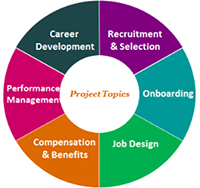
Taking into consideration the syllabus of the HR Management module, PeopleFirst designed and supervised a project that required students to apply theoretical concepts, undertake a study and develop recommendations to address a variety of HR topics (see diagram on left) that employers, employees and HR teams alike, deal with on a day to day basis.
In this newsletter, PeopleFirst will share the recommendations from the project giving potential employers insights into the expectations of the Centennial generation.
In recognition of their efforts and in order to motivate the students, PeopleFirst donated a sum of AED 1,000 to the winning team (Job Design). The money was donated to Albustan Charity Association which was chosen by the students with the highest scores.
Let’s start by understanding more about the Centennial generation
Centennials, also known as Generation Z, are the generation of people born roughly between 1995 and 2008. It is expected that by 2020, Centennials will make up 20% of the workforce, making it important for us to understand how to prepare for the next Centennial workforce.
The most prominent difference between Centennials and other generations is that Centennials have never experienced a world without the internet. They have been brought up in vastly different circumstances than the Millennials, shaping them to be more tech savvy, educated, and can achieve what they set out to do with greater efficiency because of easier access to information.
The illustration below looks at Centennials in more detail:
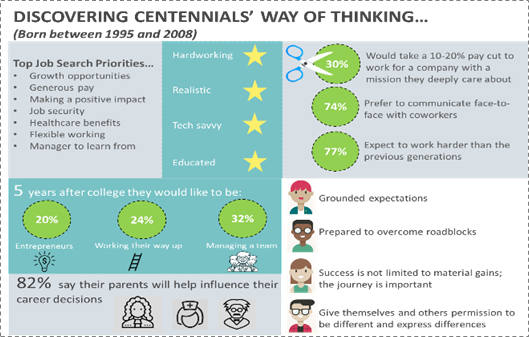
Winning Team: Leon Halal, Sarah Farah, Sofiya Karaboikova, Mohammad BinHendi, Richelle Soni, Diana Saloum
HR Topic: Job Design
Task: Design the ideal job for a Centennial which includes job purpose, job title, job role and responsibilities, working hours and employee expectations
The key research findings and recommendations presented by the winning team are summarized below:
- Job Autonomy: Centennials like to be in control of their progress and are willing to work hard when they are passionate about the results. 40% of the respondents said they want to be accountable for their actions and 34% agreed that they prefer a decentralized organization structure. The students recommended that future employers take advantage of this insight by redesigning the organization’s hierarchy in a way that would allow Centennials to work under limited supervision with more room for creativity and accountability.
- Job Variety: Centennials have shorter attention spans than the generations that preceded them and they excel at multi-tasking, making them more inclined towards task variety in their jobs. Only 30% of the respondents showed preference for working on a single task at a time, while the majority (49%) of respondents wanted to experience a variety of tasks in their job roles. Therefore, we recommend that employers broaden the scope of jobs in order to boost motivation levels, employee engagement, and productivity amongst Centennials.
- Flexible Working: Centennials not only enjoy variety in job tasks, but also look for flexible working arrangements. The students reported that when it comes to flexibility about when, where and how they work, Centennials prefer not to be restricted by rigid rules such as fixed work timings and fixed desk spaces. Research indicates that Centennials find it unfair to be considered ‘late’ for work if they arrive fifteen minutes after the start time, which in their opinion, can be made up at the end of the work day. The students recommended that employers should include flexible working hours in their HR policies and focus more on the quality of work rather than time spent at work. In addition, we recommend introducing ‘hot-desking’ as an innovative way to encourage a flexible and friendly work environment.
Team: Ayan Ali, Joe Karam, Zubier Hammadi, Mohamed Hamoud, Saakshi Rochlani
HR Topic: Onboarding
Task: Design an Onboarding process tailored to the needs of Centennials
The students at AUD surprised us with an in-depth report on what Centennials expect on joining the workplace. The research findings are summarized below:
- Centennials are tech savvy and learn better through interactive videos / activities as opposed to an oral introduction to concepts. We recommend that employers use gamification to introduce the organization’s vision, mission, values and key policies.
- Centennials are more productive in a friendly work environment and employers can break the ice by inviting the new joiner to a team breakfast/lunch as soon as they join. In addition, the students recommended that employers should develop a ‘buddy’ system to introduce them to the organization and guide them through the first few weeks of employment.
- On the job training was a popular recommendation amongst the students because research suggests that the education system today does not fully prepare Centennials for the workplace and they expect to develop their skills on the job.
- The students recommended that employers provide a welcome kit to all new joiners and include in it the job description, organization chart, employee handbook, etc. We recommend making it more interesting by providing the welcome kit in the form of a mobile app which they can easily download and access in their own time.
- Further research on the topic suggests that offering company branded gifts like a mug, stationery, t-shirt and stickers help develop a positive image of the company when Centennials’ share photographs of their branded welcome gifts on social media networks.
We strongly recommend that Onboarding should not be a short-term process, but rather new joiners should be mentored throughout their employment with the company.
Team: Heba AlSawalhi, Omar Sabban, Abdulla Ghazali, Bassem Abou Daya, Hamza Barahim, Ahmad Khaled
HR Topic: Career Development
Task: Design a career development process that balances the needs of an organization whilst motivating Centennials to grow with the company
27% of Centennials believe they should stay in their first job for a year or less. For employers, this can mean potential employee retention problems, which they can solve through the application of career development initiatives. Research on the topic revealed:
- Centennials place great emphasis on personal growth. If their needs for personal development are not met, they will not hesitate to look for a new job that offers better professional growth opportunities.
- Centennials have received more guidance from their parents and teachers than any other generation before them, which is why they expect some direction from their employers. Therefore, they expect to be mentored and trained continuously without being micromanaged.
- Centennials want to make an impact. They have specific expectations of how they want their career to progress and they look to their managers for one to one feedback on how they can continue to develop themselves in order to achieve professional success.
- Centennials value job security. Therefore, if a company invests in the development of its employees and keeps them engaged, the employer will be able to implement a successful succession planning framework, developing the next generation to become effective leaders!
We recommend that employers focus on customizing the career development framework to meet the expectations of the new generation in order to increase employee retention and also encourage professional growth amongst their employees.
Team:Ali Owji, Deena Abu Al Saad, Gurmeet Kapoor, Jimmy Bleibel, Mutasem Kuttenie
HR Topic: Recruitment
Task: Design a robust recruitment process that is tailored to attract Centennials
The research conducted by students on this topic focused mainly on answering the questions around what will enable potential employers to attract Centennials.
- The students found that Centennials value social aspects of the work environment more than anything else when they are looking for a new job. Having good relationships with colleagues and their bosses, working in a happy environment and being surrounded by supportive and encouraging colleagues is important to them. Therefore, we recommend that employers focus on creating a positive work environment that encourages teamwork, mentoring and positivity. Employer branding can play an important role in attracting Centennials.
- The next thing Centennials look for when they apply for a new job is promotion opportunities in the workplace and an above average compensation & benefits package. While everyone wants a better salary package, Centennials are more eager to earn their way to the top. Therefore, it is important for employers to introduce the opportunities for growth while recruiting for the new position.
- Centennials also look for challenging work and innovative employers that encourage forward-thinking. One of the ways through which employers can demonstrate this creativity and open-mindedness is by using innovative means of advertising vacancies.
We suggest that employers do not ignore any aspect of these findings when designing an advertisement for recruitment.
Team: Dana Ismail, Hakim Hussein, Sandra Ghorayeb, Sultan Mohamed, Muhammed Al Gargawi
HR Topic: Compensation & Benefits
Task: Design a Compensation & Benefits framework to help attract and retain a young Centennial
The students found that Centennials value transparency and would like to know that the company follows a fair and transparent grading system that justifies why employees are paid differently. The research indicates:
- Centennials are not only looking for monetary rewards, but are looking for benefits such as flexibility in working hours, health club memberships, corporate discounts for retail and hospitality, health insurance and interest free car loans. The students suggested that Centennials are likely to stay longer with a company that offers such benefits.
- Centennials value having benefits and compensation personalized around their individual lives rather than receiving fixed and standard packages. Therefore, employers may benefit from looking for innovative and personalized ways to reward their employees in non-monetary terms.
- Centennials are likely to pursue further studies after starting their careers. A popular benefit that Centennials seem to seek from their employers is allowance for further studies. This can be a benefit not only for the employee, but also for the employer.
Team: Basel Abotteen, Nawar Aji, Mustafa Hassan, Khaled Rahmo, Joseph Zakhia
HR Topic: Performance Management
Task: Design a performance appraisal process for Centennials, considering the frequency of reviews, employee ratings, link to reward and handling poor performance
The students suggest that the key to better operational performance is effective performance management.
- Centennials want instant feedback on their performance and they prefer to receive this feedback in person because they see it as an important contributor to their personal and professional growth. Therefore, we recommend that employers provide constant feedback in order to obtain immediate results. The focus of appraisals should be performance development and instant feedback is likely to have positive results.
We enjoyed the experience of working with the students and faculty at AUD and were impressed with the quality of work presented to us. We wish potential employers the best of luck in attracting and retaining the new generation workforce!
Innovation is changing the HR world today. Technology is bringing improvements in speed, service and quality, however, many HR departments have continued operating throughout the years as they have always done and have not evolved to take advantage of the opportunities available from the new technological developments.
Instead of embedding outdated processes, HR professionals should re-think the way they operate and ensure that they make the best use of technology, systems and communication. The focus should be on innovating new ways to solve old problems. HR needs to re-visit, evaluate and update its processes to ensure that the HR department provides high value-adding levels of service.
What is HR process re-engineering?
HR process re-engineering is all about optimization and continuous improvement. It is the fundamental rethinking and radical redesign that leads to an increase in productivity. The aim of process re-engineering is to improve the level of process performance in order to achieve significant and sustainable improvements in the performance of your HR department. Through HR process re-engineering, HR professionals can re-think how they operate and find better or improved ways to provide HR services.
What steps are involved?
HR process re-engineering consists of six fundamental steps as shown in the figure below:
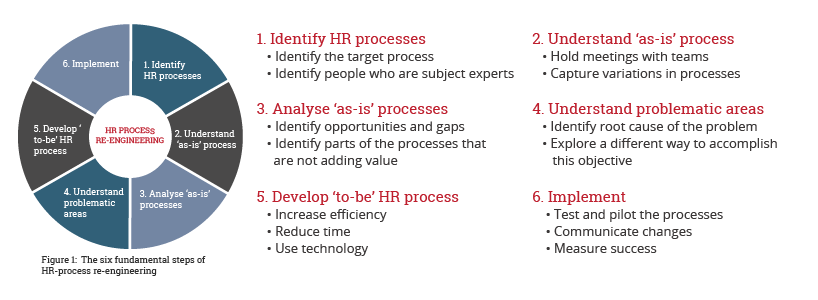
HR process re-engineering starts with data gathering to understand the current activities and processes. It is important to involve the key subject experts at this stage as they know the processes and problematic areas in detail. A focus should be placed on the analysis stage, considering end users and internal requirements to ensure a successful outcome. When re-designing, each activity should be challenged to ensure that duplications and blockages are removed and unnecessary steps and processes are eliminated. Implementation is one of key steps in successful process re-engineering. To effectively implement the HR processes, change needs to be managed effectively and HR should communicate and address issues upfront to obtain buy-in.
What are the benefits and ROI?
There are many benefits of using this tool and some of the expected outcomes include:
- Reduced Cost – There are a number of areas where your company can achieve cost reduction. This includes time-savings and a reduction of error rates. In addition, when a self-service option is provided to employees there is potential saving in cost by reducing manpower requirements.
- Increase in departmental efficiency – Process re-engineering will drive the automation of a lot of repetitive elements and therefore you will be able to remove duplicate steps and parallel processing. The improvement will give the HR team the capacity to focus on value-added activities moving away from transactional to strategic HR.
- Employee engagement – By optimizing your HR processes you can make your employees happier as issues that they are facing can be handled faster through automation.
- Improvement in customer service levels – Process re-engineering ensures that the quality of HR services and information is delivered efficiently and consistently across the business.
When is HR process re-engineering the answer?
Knowing when and how to innovate is a challenge for every HR function. A close and critical assessment of HR processes will provide clarity and focus on whether a re-design of an HR process is required. Some of the red flags include:
- The presence of non value-added activities e.g. using both excel/spreadsheets and I.T for tracking purposes
- Duplication in steps for process completion e.g. multiple data entry
- Deviations in the process e.g. difference in requirements for the same service
- SLAs are not adhered to
- Disconnect between end-user requirements and the services provided
PeopleFirst is experienced in HR process re-engineering. We have worked with a range of clients to analyse their current HR processes and systems and aligned them to business needs, thus helping the organization move forward towards fulfilling its long- term vision. We further provide end-to-end outsourcing solutions through an online, cloud-based portal where we help companies to streamline and automate their HR processes.
On behalf of PeopleFirst, I am pleased to formally launch the Leaders for Tomorrow programme. This is a CSR initiative developed and managed by PeopleFirst and is aimed at providing young individuals (graduates & post graduates) across the UAE with an opportunity to connect and interact with experienced professionals from different industry sectors through a structured mentoring programme.
The programme provides a structured framework to initiate and facilitate mentoring relationships that will support many young individuals across the region in their professional development. At the same time it will give working professionals the opportunity to give back to their communities and shape the future generation of leaders.
We need your support to help make this programme a success. Download the programme guidelines (see link below) that tell you everything you need to know about the programme. Please take a moment to read this and get in contact if you would like to be a Mentor or if you would like to take part in the programme as a Mentee.
Contact us at leaders@peoplefirstme.com and lets give back by sharing our experiences and developing talent for the future!
Although the beginning of the year started off with a feeling of uncertainty, it appears we are now finally headed towards some positive news. GDP growth which was at 2.0% at the beginning of the year has picked up and is expected to continue to rise, reaching an expected figure of around 3.4% in 2018. On the other hand, the introduction of VAT is likely to raise inflation from 3.7% in 2017 to 4.8% in 2018.
So, what does this all mean for salary pay trends in the UAE for 2017-2018, and how will this affect employers and employees?
Basic Salary
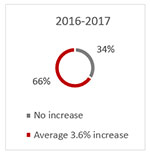 In 2016-2017, the overall trend for increase in basic salary was about 2.5% in the UAE. The diagram on the left summarizes the percentage of people that received an increase in basic salary versus those who received no increase, in companies that implemented a pay review in 2017. 66% of the employees received an average increase of 3.6% in their basic salary, while 34% of the employees did not receive any increase in basic salary.
In 2016-2017, the overall trend for increase in basic salary was about 2.5% in the UAE. The diagram on the left summarizes the percentage of people that received an increase in basic salary versus those who received no increase, in companies that implemented a pay review in 2017. 66% of the employees received an average increase of 3.6% in their basic salary, while 34% of the employees did not receive any increase in basic salary.
So how did this further break down across all job levels, grades and industry sectors? The tables below summarize the differences in basic pay trends at different job levels and across industry sectors during 2017.

While senior management and management level employees enjoyed pay rises between 2.4% to 3.0%, increases for clerical roles were as low as 1.8%. Moreover, there was a complete reversal in the pay trends across industry sectors this year. In 2016 we saw Healthcare, FMCG, Technology and Automotive industries enjoy the highest increase which went up to as high as 7.0%. However, this year, these very industry sectors have seen the lowest increase. In fact, the Healthcare industry saw a decrease of up to -1.0% in 2017. The Transportation, Logistics and Cargo industries enjoyed the highest increase during 2017 which went up to 4.0%, followed by the Insurance, Retail, Pharma and Education sectors.
UAE Nationals
2016-2017 saw the gap between the salaries paid to UAE Nationals versus Expatriates grow, with UAE Nationals being paid 40% to 60% higher on guaranteed cash. At lower level roles the difference was around AED 2,500 per month, however at higher level management roles this gap was as big as AED 10,000 per month.
Allowances
While basic salary increased by 2.5%, allowances increased by only about 1.5% in 2016-2017. This means that guaranteed fixed cash increased by 2.1% this year. Allowances remained at the 60:40 split and housing allowances were as good as frozen. While this may not have affected residents of Dubai negatively, as housing rental costs dropped by 5.0%, residents in Abu Dhabi would have felt the squeeze as housing rental costs in Abu Dhabi increased this year.
Bonus Payment
Actual bonus payments in early-2017 were at about 85% of On-Target which was down from 90% of On-Target from the previous year. The overall impact of this puts the increase of total cash earnings at about 2.0% compared to 1.9% in 2016.
Benefits
This year, the average school fees and medical insurance costs in the UAE increased as illustrated in the table below.

As a result of this, the overall cost of benefits rose by 5.0% to 7.0% and became a cause for concern as the limits were not in line with the actual expenditure. In fact, education allowances in 2016-2017 were seen to be reimbursed at an average of 70.0% to 75.0% of the actual costs, continuing to make it more of a subsidy rather than an allowance.
In conclusion, after studying the pay trends from 2012 up to 2017, and analyzing the forecasts for 2018, it seems that pay trends will remain stable at 3.0% in 2018. However, if we look at this in terms of real increases (after the impact of inflation), it appears that pay increases will not keep pace with inflation in 2018, just like 2017.
What Should You Be Doing in 2018?
The Market seems to have picked up in the Q3 & Q4 of 2017, and there is a positive feeling that things will continue to look up in 2018 as Expo approaches. The biggest indicator of this is the double-digit attrition rates, which has been the highest since 2007 and is expected to fuel a boom in the economy.
Here are our top two tips for employers and business owners that will help to prepare for 2018:
- It will be important to have robust retention policies to retain talent, however these should cover more than just elements of compensation and benefits. More and more young talent are looking at more than just the pay cheque to keep them motivated and engaged with an organisation and therefore having robust retention policies in place can add value to the organisation
- Consider your readiness to attract talent from Generation Z which has already started to enter the workforce. This generation has very different expectations from their future employers, so you may need to review your HR practices in order to be prepared. For more information on how to prepare for Generation Z, refer to our newsletters on ‘The Future Summit’ and ‘Ready for the Centennial Workforce?’
If you would like assistance and support with any of the recommendations above, or to review your compensation and benefits packages please do not hesitate to get in touch with us on info@peoplefirstme.com.
Our Managing Director, Asma Bajawa, was invited to speak at a conference in Karachi, Pakistan in October. This conference, called The Future Summit, focused on the digital era and explored how leadership is likely to develop in the years to come. As one of the guest speakers and panel members, Asma spoke about Generation Z (people born between 1995 –2010) and how this future workforce is shaping up in Pakistan. The focus of Asma’s session was to help employers prepare for this upcoming generation of employees.
Building on our collaboration with the American University in Dubai (AUD) earlier this year, we decided to extend our research into Generation Z to include Pakistan. Our aim was to look closer into this generation and see if there were any significant differences between the UAE and Pakistan as an indication of cross country and cross-cultural differences. As a result, PeopleFirst conducted an online survey and face to face interviews of c200 Generation Z university students in Pakistan.
Our research found that there are no significant differences in the views and expectations of our sample of Generation Z, in Pakistan versus the UAE; in fact there were many similarities. This exercise led us to investigate further and understand more about the factors that have shaped and influenced this generation; what makes them tick and what are their expectations when it comes to the work place.
Generation Z, a generation of ‘digital natives’ have been shaped by a number of different factors such as globalization, which has a lot to do with how fast digital technology has spread and connected people across the world. They have lived their whole lives in an information age where they don’t need to wait for a response. The answers they want come to them immediately through smartphones and tablets. They prefer communicating in real-time, which is made easy for them through digital technology.

Generation Z has been brought up by Generation X and have spent their formative years listening to bad news about the economy. Some of them have seen their parents lose jobs and struggle to pay the bills and therefore, this has played an important role in shaping their thoughts on debt, fiscal planning and job security.
Moreover, having been exposed to constant news about global warming, Generation Z feels strongly about taking action to fix global issues rather than ignore them, which has shaped their thoughts on social responsibility. All this helps to explain some interesting facts about Generation Z as illustrated on the right.
Coming back to the conference, Asma also took into consideration some local issues in Pakistan that will impact what employers need to think about going forward:
- There has been a 50% increase in the number of female workers in Pakistan since 2000
- There is an increase in the number of students receiving higher education
- Technology has made processes more efficient
- Businesses don’t just serve local markets anymore, they go global
- Employment laws and working practices are evolving
Keeping in mind the expectations of Generation Z along with the evolving trends in Pakistan, Asma discussed HR initiatives that employers can take to attract and retain bright young talent. This covered the following areas:
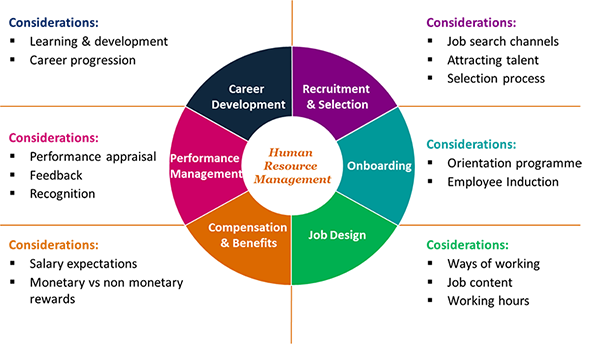
1. Recruitment and Selection
- Employer branding matters! Employers should focus on CSR initiatives to attract young talent that care about your company’s cause
- CV screening may not be the most appropriate method of shortlisting as many young people have not worked before and therefore they do not believe a CV is the best way to shortlist them
- Games and face-to-face interviews along with a ‘’one-day trial’’ may be a good way to assess potential employees
2. Onboarding
- During the orientation process, employers should include information about the company’s internal culture and team rather than information readily available online
- The onboarding process should be interactive to help new joiners mingle and get to know their new colleagues
- Branded give-aways are a great idea as new joiners from Generation Z will definitely post a picture on social media which is great for employer branding
3. Job Design
- Allow them to take responsibility but be on hand to support and coach them if needed
- Assign a mentor, but don’t micro manage!
- Create an office environment that gives a sense of belonging and ‘my space’
- Consider flexible working options. Generation Z do not want to me be manged by the clock. They are happy to work hard and be stretched but don’t want to hang around if there is nothing to do
- Don’t exclude Generation Z just because they are new. They are happy to have a go so give them a chance
4. Compensation and Benefits
- Rethink your compensation and benefits packages as Generation Z would prefer a balance of monetary and non-monetary elements such as sports club memberships and travel opportunities which are little more unconventional
- Generation Z want to be recognized if they do good work so it will be important to have reward schemes that can give on the spot recognition
5. Performance Management
- Do away with annual appraisals. Instead, incorporate a mechanism for regular/continuous feedback conversations
- Provide feedback through face-to-face conversations where the focus should be on development and recommending ways to improve
- When they do well make sure you recognise and celebrate their successes and achievements
6. Career Development
- Generation Z definitely learn differently so offering a more diverse range of training options will be important
- Explore methods to provide training outside of the work space
Our insights into Generation Z have helped us to understand some of the specific needs of this generation and the potential benefits they will bring to the workplace. We cannot wait to see these changes start to take place in the organisations that we work with!















